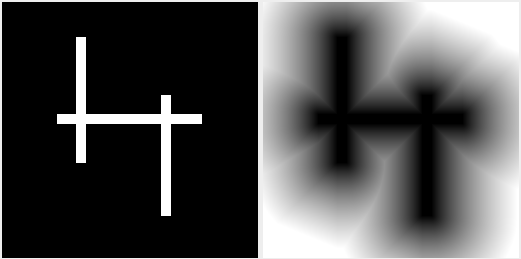1
2
3
4
5
6
7
8
9
10
11
12
13
14
15
16
17
18
19
20
21
22
23
24
25
26
27
28
29
30
31
32
33
34
35
36
37
38
39
40
41
42
43
44
45
46
47
48
49
50
51
52
53
54
55
56
57
58
59
60
61
62
63
64
65
66
67
68
69
70
71
72
73
74
75
76
77
78
79
80
81
82
83
84
85
86
87
88
89
90
91
92
93
94
95
96
97
98
99
100
101
102
103
104
105
106
107
108
109
110
111
112
113
114
115
116
117
118
119
120
121
122
123
124
125
126
127
|
/**
* Chamfer distance
*
* @author Code by Xavier Philippeau <br> Kernels by Verwer, Borgefors and Thiel
*/
public class ChamferDistance {
public final static int[][] cheessboard = new int[][] {
new int[] {1,0,1},
new int[] {1,1,1}
};
public final static int[][] chamfer3 = new int[][] {
new int[] {1,0,3},
new int[] {1,1,4}
};
public final static int[][] chamfer5 = new int[][] {
new int[] {1,0,5},
new int[] {1,1,7},
new int[] {2,1,11}
};
public final static int[][] chamfer7 = new int[][] {
new int[] {1,0,14},
new int[] {1,1,20},
new int[] {2,1,31},
new int[] {3,1,44}
};
public final static int[][] chamfer13 = new int[][] {
new int[] { 1, 0, 68},
new int[] { 1, 1, 96},
new int[] { 2, 1, 152},
new int[] { 3, 1, 215},
new int[] { 3, 2, 245},
new int[] { 4, 1, 280},
new int[] { 4, 3, 340},
new int[] { 5, 1, 346},
new int[] { 6, 1, 413}
};
private int[][] chamfer = null;
private int normalizer = 0;
private int width=0,height=0;
public ChamferDistance() {
this(ChamferDistance.chamfer3);
}
public ChamferDistance(int[][] chamfermask) {
this.chamfer = chamfermask;
this.normalizer = this.chamfer[0][2];
}
private void testAndSet(double[][] output, int x, int y, double newvalue) {
if(x<0 || x>=this.width) return;
if(y<0 || y>=this.height) return;
double v = output[x][y];
if (v>=0 && v<newvalue) return;
output[x][y] = newvalue;
}
public double[][] compute(boolean[][] input, int width, int height) {
this.width = width;
this.height = height;
double[][] output = new double[width][height];
// initialize distance
for (int y=0; y<height; y++)
for (int x=0; x<width; x++)
if ( input[x][y] )
output[x][y]=0; // inside the object -> distance=0
else
output[x][y]=-1; // outside the object -> to be computed
// forward
for (int y=0; y<=height-1; y++) {
for (int x=0; x<=width-1; x++) {
double v = output[x][y];
if (v<0) continue;
for(int k=0;k<chamfer.length;k++) {
int dx = chamfer[k][0];
int dy = chamfer[k][1];
int dt = chamfer[k][2];
testAndSet(output, x+dx, y+dy, v+dt);
if (dy!=0) testAndSet(output, x-dx, y+dy, v+dt);
if (dx!=dy) {
testAndSet(output, x+dy, y+dx, v+dt);
if (dy!=0) testAndSet(output, x-dy, y+dx, v+dt);
}
}
}
}
// backward
for (int y=height-1; y>=0; y--) {
for (int x=width-1; x>=0; x--) {
double v = output[x][y];
if (v<0) continue;
for(int k=0;k<chamfer.length;k++) {
int dx = chamfer[k][0];
int dy = chamfer[k][1];
int dt = chamfer[k][2];
testAndSet(output, x-dx, y-dy, v+dt);
if (dy!=0) testAndSet(output, x+dx, y-dy, v+dt);
if (dx!=dy) {
testAndSet(output, x-dy, y-dx, v+dt);
if (dy!=0) testAndSet(output, x+dy, y-dx, v+dt);
}
}
}
}
// normalize
for (int y=0; y<height; y++)
for (int x=0; x<width; x++)
output[x][y] = output[x][y]/normalizer;
return output;
}
} |
















 Répondre avec citation
Répondre avec citation
Partager